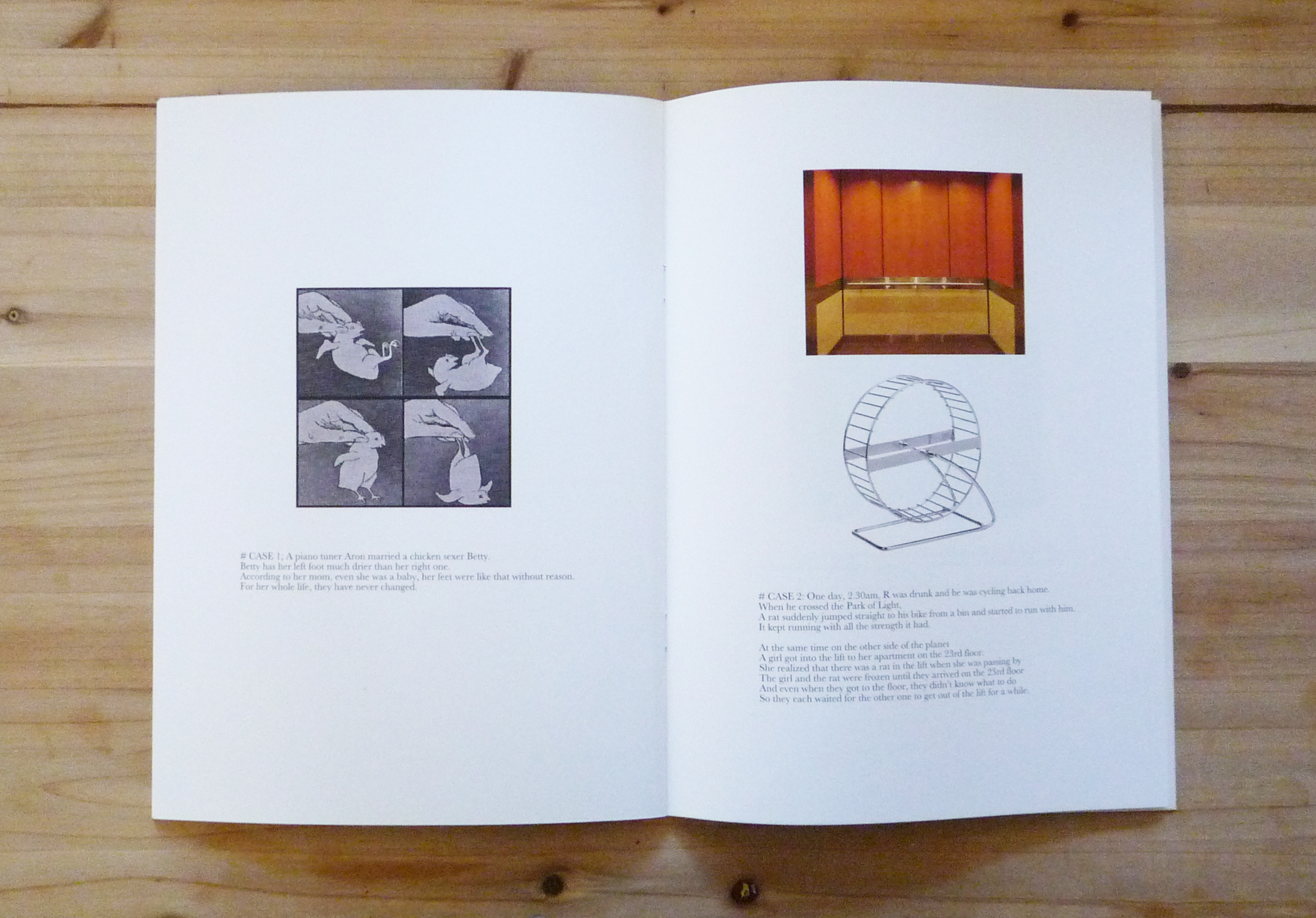사육장의 사람
Triple Channel Video
Aporia Trilogy Part III
I. Ch1, 4K, stereo sound, 04’10 (projector/speaker)
II. Ch2, FHD, stereo sound, 20’00 (tv 75 inch /headphone)
III. Ch3, FHD, stereo sound, 20’00 (tv 75 inch /headphone)
Channel I
Channel II&III (Integrated Version)
Installation View


홈커밍
Site-specific Lage-scaled Installation
Concrete, Steel, Wire Mesh, Found Lamppost, Light


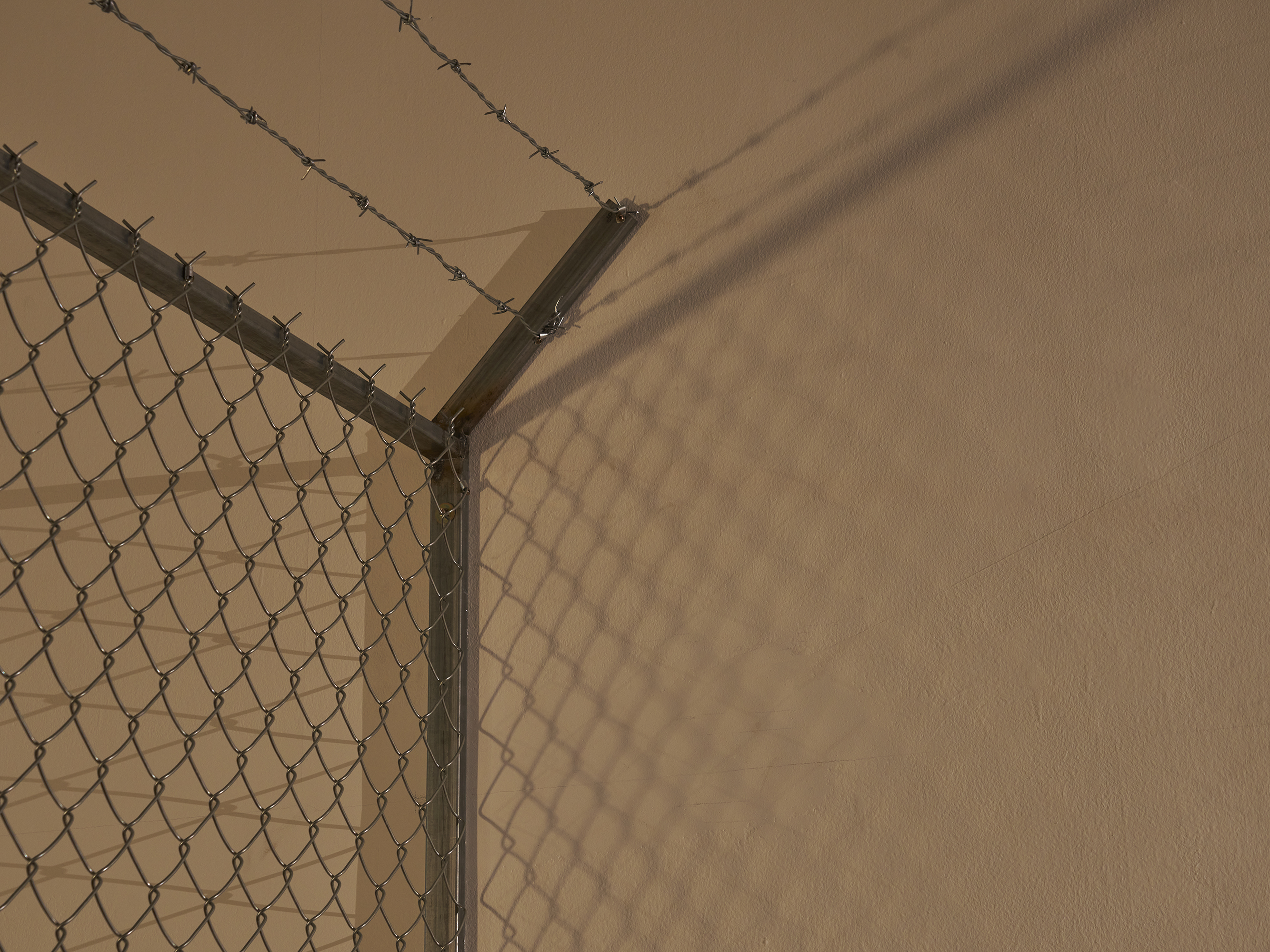

눈꺼풀 없이
Mixed Media, Dimensions Variable
<눈꺼풀 없이>(2023)는 같은 전시 공간 안 유리 위에 전사된 글 <투명한 몰락의 밤>(2023)을 해부하여 시각화한 설치이다. 총 3개의 파트로 나눠진 이 중소형 오브제 설치는, 유리, 종이, 나무라는 3개의 물질을 토대로 쓰다만 양초, 계란 껍질 파편, 돋보기 렌즈와 인조 속눈썹 등과 같은 일상의 오브제들이 함께 조합된 외견을 갖고 있다. 작가는 2021년부터 본인의 글과 시각적 표현을 분리하여 구현하는 방식을 실험하고 있으며 이 작업 역시 그 일환의 하나로 여겨진다. 글에서 파생된 무형의 이미지들은 구체적인 형상으로 치환되고, 그렇게 변모한 모습으로 다른 맥락에 놓여 보는 이에 따라 새로운 서사를 생산한다. 작가는 이렇게 언어적 비언어적 영역 모두에서 발생하는 시적 효과와 그것이 작동하는 메커니즘을 통해 "없는 것"을 공간 안에 구현하는 시도를 이어가고 있다.
<Without Eyelids>(2023) dissects and visualises one of the other works presented in the same space, <The Transparent Night of Downfall>(2023), whose text is transcribed on a plate of glass. Consisting of three parts, this middle-sized installation combines its three main matters--glass, wood and paper with several ordinary objects we can often come across, such as a half-used candle stick, eggshell fragments, magnifying lenses and fake eyebrows. Since 2021, Jung has experimented with her methodology to separate visual expressions and fiction when they share a particular narrative. In her latest practice, the intangible images arising from the original text shift into specific figures; the changed appearance placed in a different context produces a new story depending on whoever appreciates it. By exploring the poetic effect occurring in both linguistic and non-verbal realms and its mechanism, Jung constantly attempts to construct "the absent" in a space.




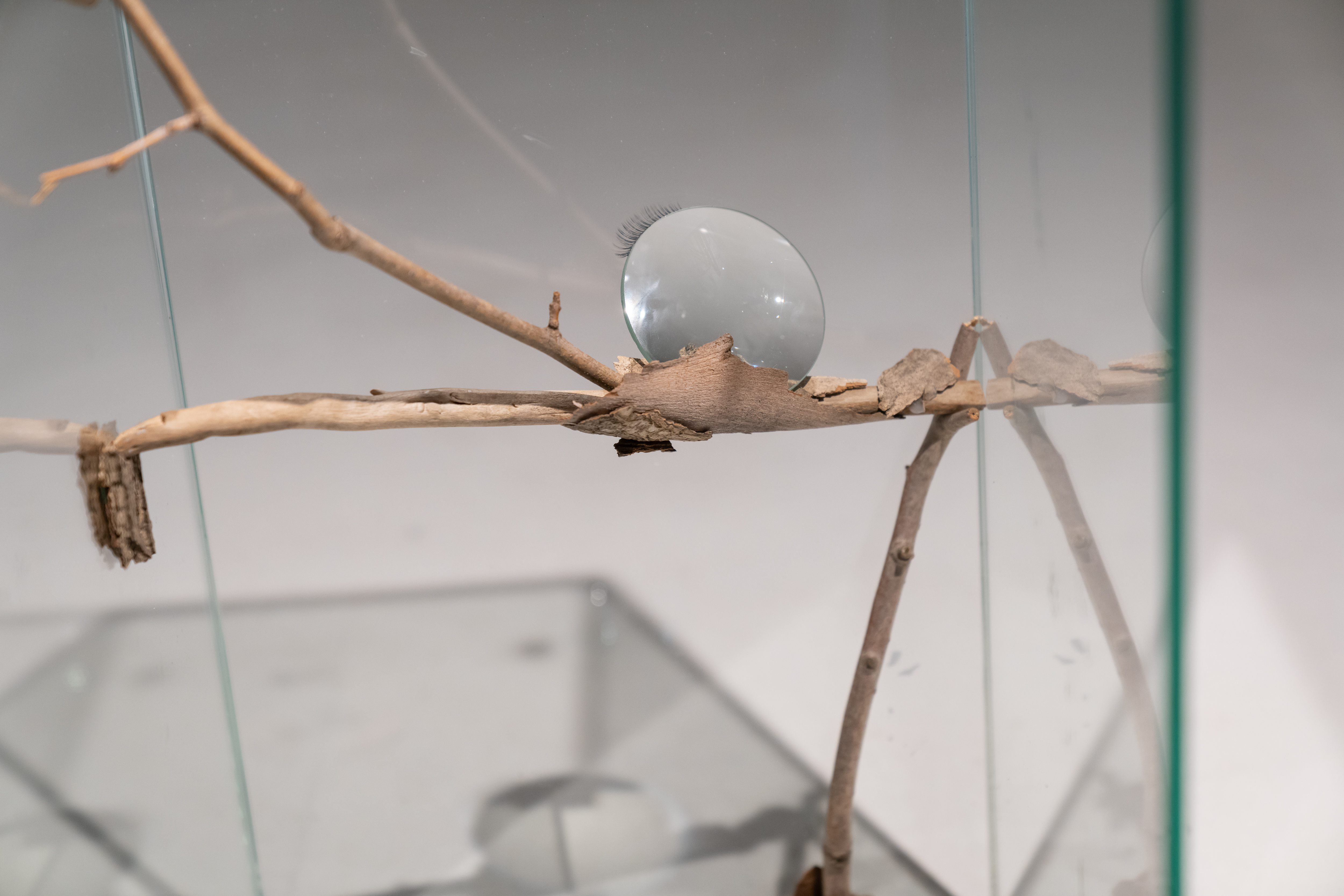

투명한 몰락의 밤
The Transparent Night of Downfall
Neither Asleep Nor Dead
10.
생선가시가 달에 걸린 밤
9.
강바닥에 누운 몸, 물처럼 투명하다.
8.
별들은 빗물 고인 구덩이에 빠졌다.
7.
토성은 띠를 벗고 추락한다.
6.
눈꺼풀 벗겨지고, 각막은 수면위로 떠오른다.
5.
불길한 예언은 맞아 떨어졌고, 영원히 눈 감을 수 없다.
4.
어린 물고기들은 금속 맛 부드러운 살을 베어물고 따뜻한 피를 빨아먹는다.
3.
달은 지구를 버리고 도망친다.
2.
텅 빈 둥지로 물빛만 드리운다.
1.
비로소 알게된 가장 아래로 가라앉는 혼자만의 기쁨!
0.
물밑에서 하늘이 어떻게 잠기는지 바라본다. 오지 않는 아침을 기다린다.
1.
Syntax (of Daydream) I-V(2019)
공상의 문법 IV-V
Syntax (of Daydream) IV
공상의 문법 IV
28.5 x 39 x 9cm
Mixed Media
Syntax (of Daydream) V
공상의 문법 V
28.5 x 39 x 9cm
Mixed Media
Syntax (of Daydream) II, III
공상의 문법 II, III
14.7 x 20cm (Each)
Paper Collage, Found Frame

Syntax (of Daydream) I
공상의 문법 I
27 x 32cm
Paper Collage, Found Frame
2.
Syntax (of Sleep) I-III (2021)
16x92.5x5.5cm (EA)
Mixed Media
작가는 언어와 시각 요소의 상호작용과 괴리를 동시에 보여주는 작품을 지속해서 선보여 왔다.
2019년부터 을 시작으로 일상 사물에 깃든 시적 효과에 대해서 탐구하는 시리즈를 제작해오고 있는데 이번 전시에서 발표하는 신작 3점 역시 그 연장 선상에 놓여있다. 서사를 기반으로 한 작가의 대부분의 작품과는 다른 결을 가진 이 시리즈는 평범한 공산품의 기본적인 조형성과 추상성이 자연에서 온 생물 표본과 섬세하게 결합되어 생경한 순간을 연출한다. 마치 지속되면서 동시에 멈춘듯한 순간의 낯선 기묘함은 보는 이로 하여금 그 물체가 가진 본래의 기능과 목적 잊고 새로운 맥락으로 해석하게 만든다. 제목은 이성적으로 접근하는 데 한계가 있는 '수면'이나 '몽상'을 이해하는 것에 법칙이 있는 것처럼 말하지만 결국 그것이 가능하지 않다는 것을 암시하며 심미적 경험이 얼마나 개인적인 조건과 주관적인 관점에 기대어있는지를 '문법'이라는 말을 사용해 미묘하게 비틀고 있다.
Jung has continuously presented works that simultaneously show the interaction and disparity between language and visual elements. Starting from “Syntax (of Daydream)” since 2019, the artist has been producing the Syntax series that explores the poetic effect of objects found in everyday life. The new work "Syntax (of Sleep)" introduced at this exhibition, is also released for the series. Unlike most of Jung’s narrative-based works, this series creates an uncanny moment by delicately combining the basic formativeness and abstraction of ordinary industrial products with biological specimens from nature. The unfamiliar strangeness of the moment, which seems to continue and stop at the same time, makes viewers forget the original function and purpose of the objects and interpret them in a new context. The title suggests that we are not able in the end to discover logics about understanding 'sleep' or 'dreaming' that have limitations in rational approaches. This work uses the word "syntax" to subtly twist how much an aesthetic experience depends on individual conditions and subjective viewpoints.
3.
Syntax (of Absence) (2022)
부재의 문법
Dimensions Variable
Collected Ventilation Device Frame, Betterfly Specimen, Rope
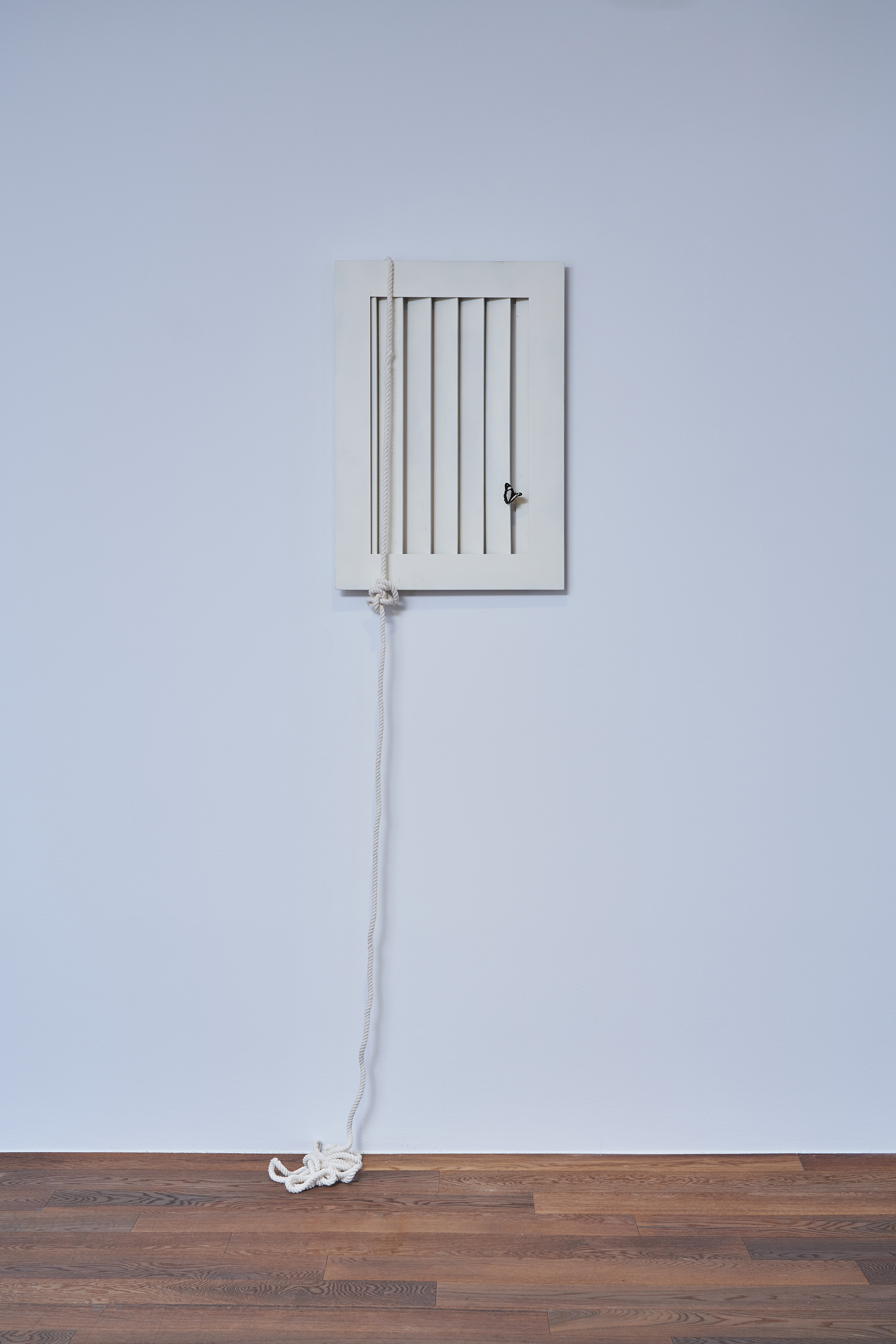
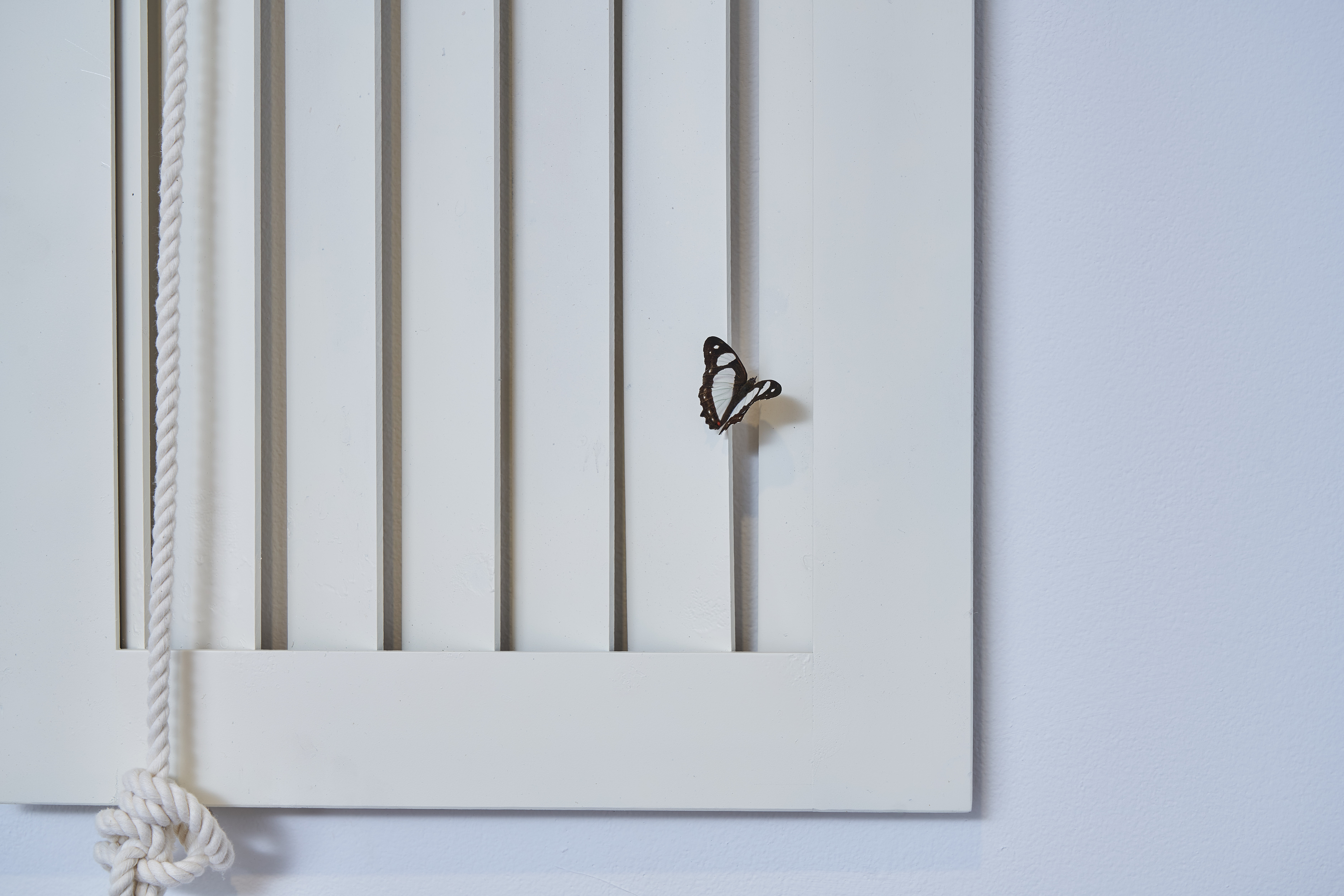
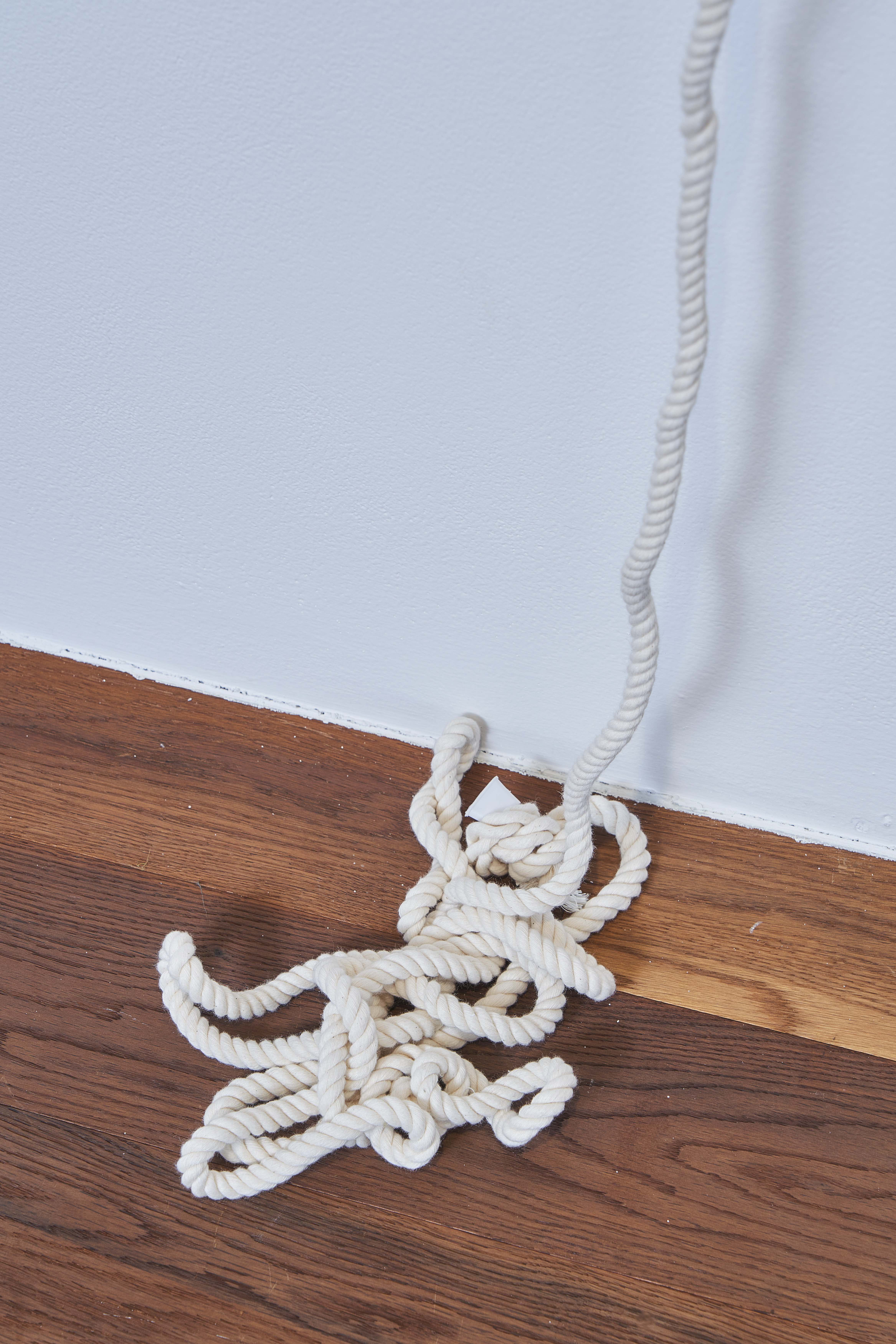
눈먼 개의 게임
1.
The Blind Dog's Maze (2020)
눈먼 개의 미로
15 x 23.8cm
Dry Decal on a Concrete Pillar
Original Source of the Image
https://en.wikipedia.org/wiki/Absurdism
* Artist's Note
와 쌍을 이루는 작품으로 인터넷에서 발견한 도표의 기준만을 남기고 주요 내용은 삭제한 작업이다. 표는 실존주의, 부조리주의, 허무주의를 간략히 비교하고 있다. 이 흥미로운 표는 ‘의미 Meaning’를 기준점으로 몇몇 삶의 태도를 제시하지만 오히려 우리가 헤메는 길 잃은 사람들이라는 사실을 역설적으로 상기시킨다.
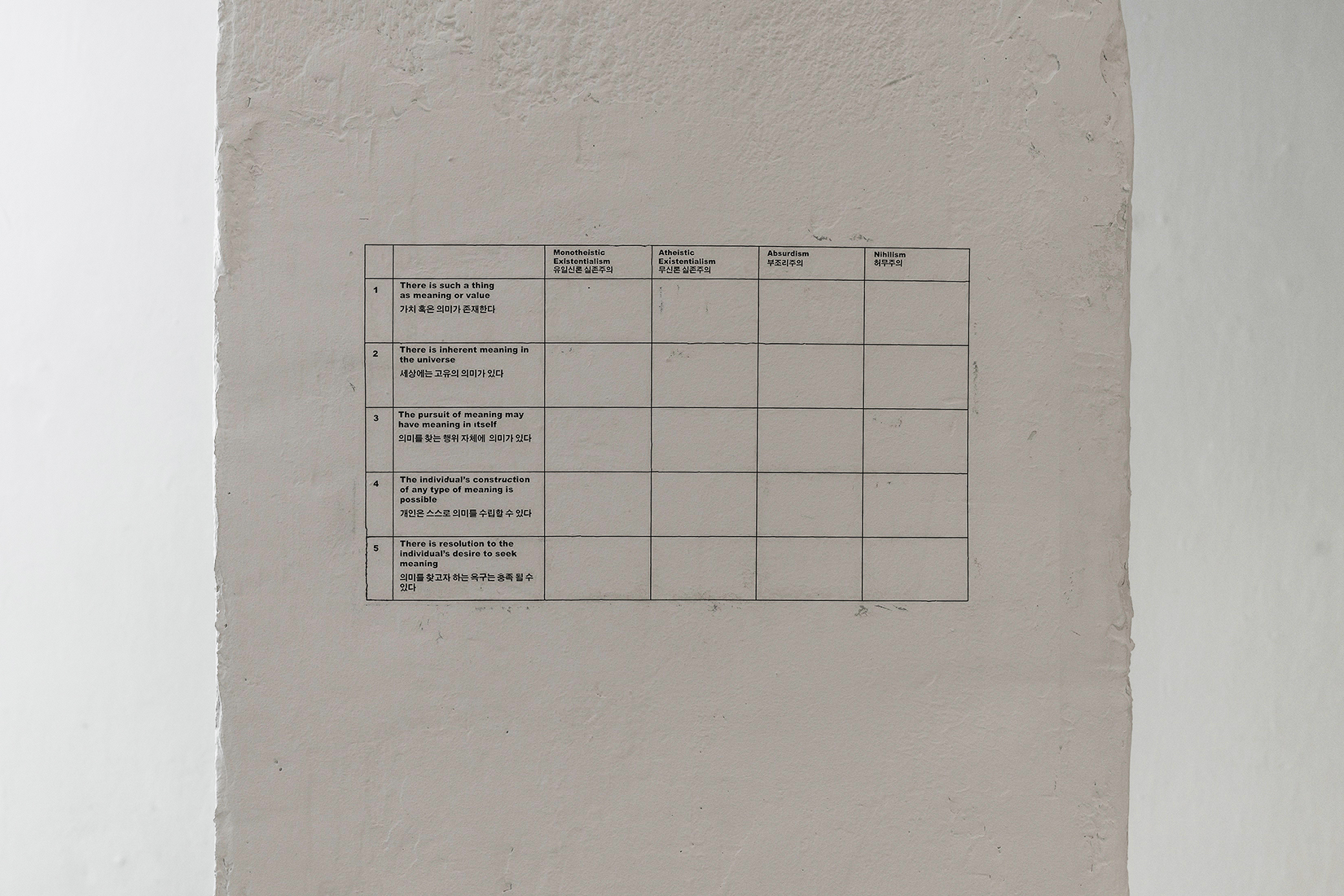

2.
The Blind Dog’s Corner (2022)
눈먼 개의 모퉁이
Dimensions Variable
Black Chess Pieces


3.
Dyslexia: The Blind Dog’s Map (2022)
난독: 눈먼 개의 지도
20x20cm(ea.)
Ink, pen on paper
No.3410 No.3773 No.3587 No.3921
No.3846 No.3771 No.3470 No.3367
No.3547 No.3915 No.3669 No. 3587
No.3423 No.3906 No.3915 No.3757
(Left to Right/ Above to Bellow)

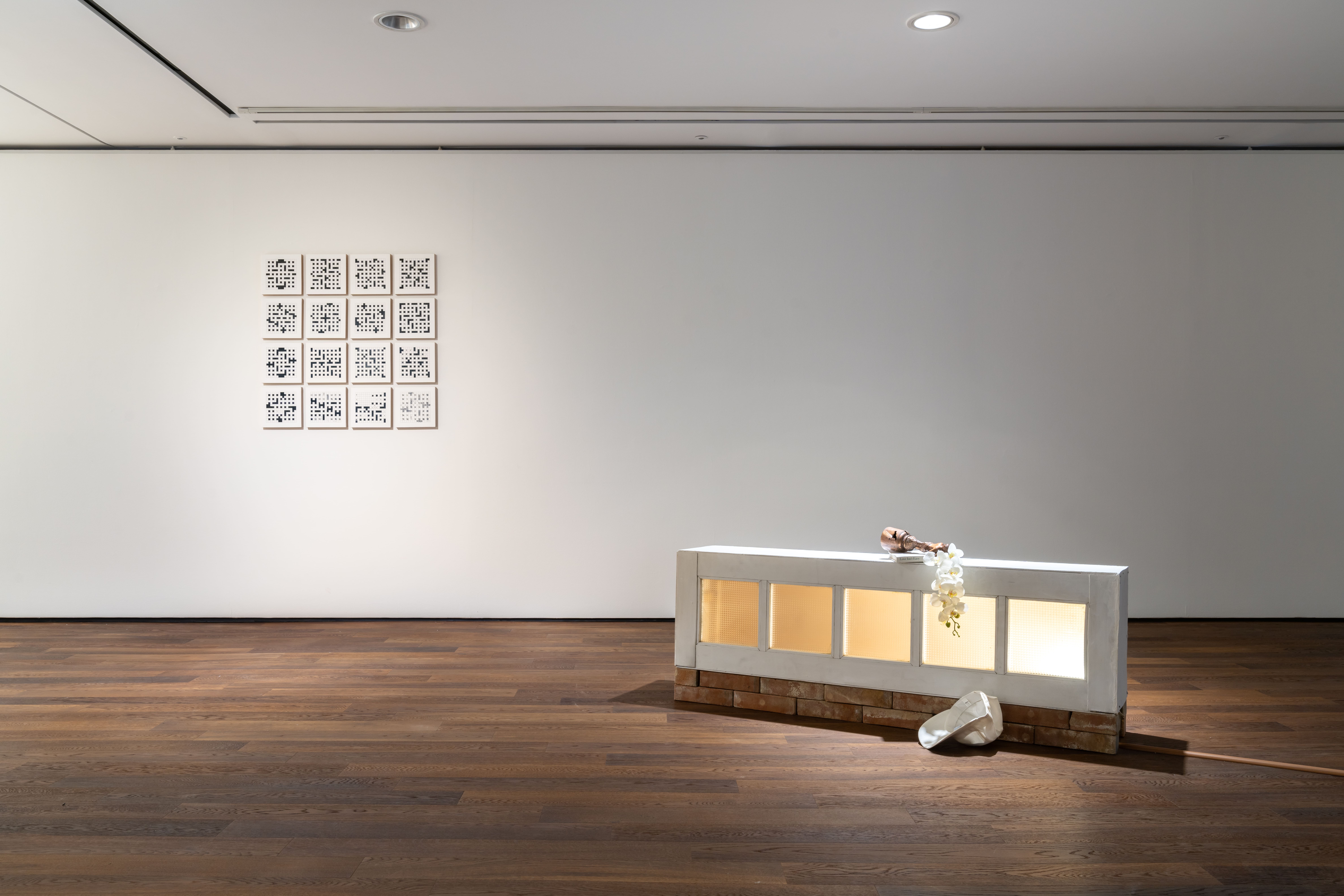
4.
The Blind Dog’s Requiem (2022)
눈먼 개의 레퀴엠
Digital Print
594 x 841 mm
부산 다대포 물때표 (2022년, 7월-11월)
The Dadaepo(Busan, KR) Tidal Current Chart & Table (July-November, 2022)
*Original Scource; https://www.badatime.com
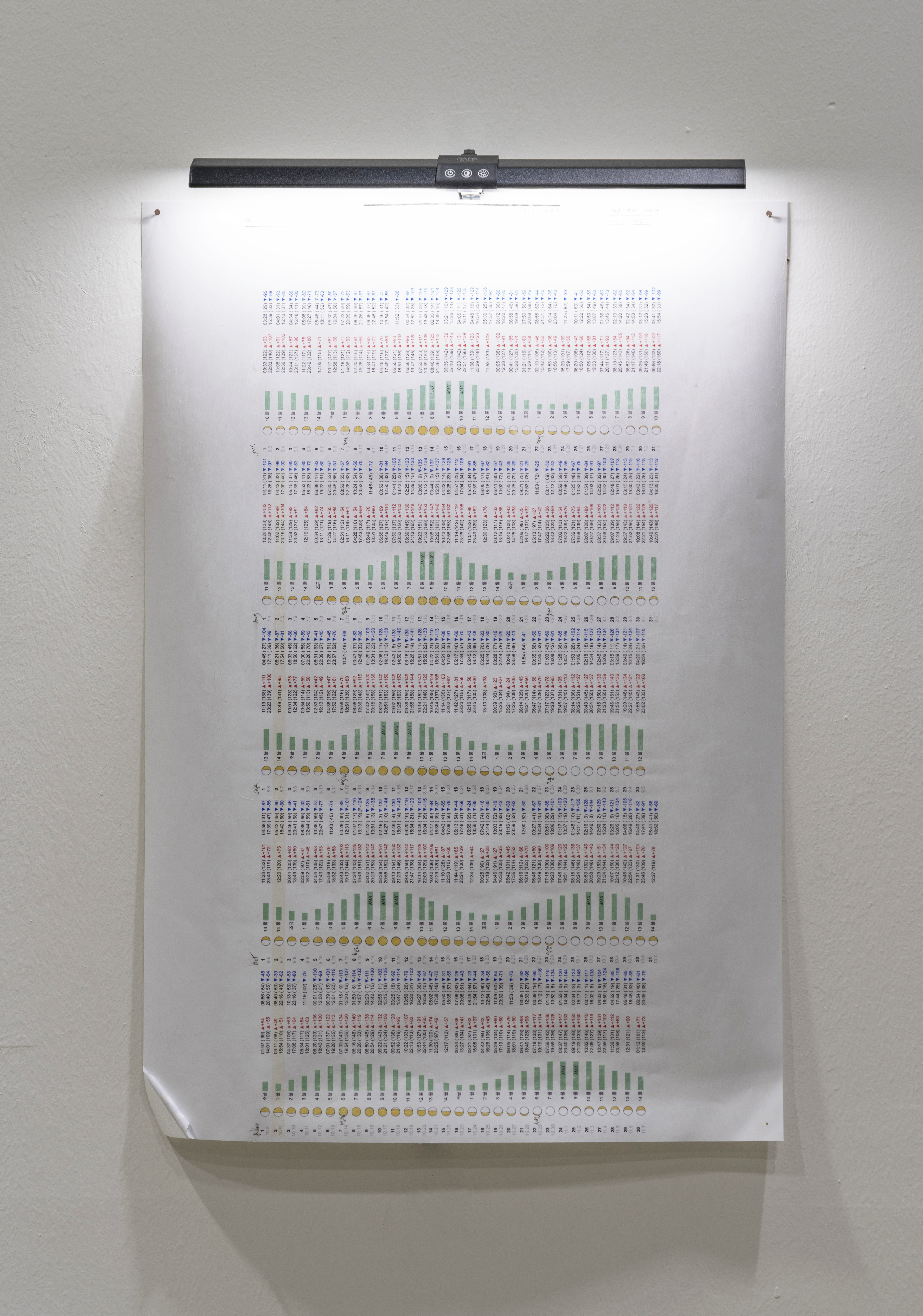
모른다는 것에 대한 열망
나는 전시를 할 때마다 어떤 책에 혹은 어떤 작가에게 기대며 걸어가는 것 같다. 이번 전시는 그런 점에서 거의 베케트의 글귀에 기대어 갔다. <저글링하는 사람>(2020, Single Channel Video) 속에는 그의 글을 일부 차용하기도 했다. 생각해보면 나는 베케트를 이해하지 못한다. 끝내 이해하지 못하는 것을 따라가다 보면 나는 알 수 없는 곳에 놓여있는 나를 보게 된다. 외국어를 이용하는 작업을 많이 했던 나는 나의 의식이, 나의 관습이, 나의 모국어가 규정하려는 것에서 도망치는 사람이었다. 한없이 도망치다 보니 여기에 있다.
전시 제목인 <당신은 믿은 게 아니라 속은 거야>는 전시 속 작품마다 희미하게 그려지는 인물들이 헤메고 있다는 점과 그들이 겪는 혼란과 어리석음을 전체적으로 묶는 말이다. 생각해보면 믿는 것과 속는 것은 대치되는 말이 아니다. 속는다는 것은 믿었다는 것이다. 그리고 속았다는 사실을 ‘모르면’ 믿음은 유예된다.
2020, Dec
전시 <당신은 믿은 게 아니라 속은 거야>(2020, 프로젝트 스페이스 사루비아)에 대한 노트
전시 <당신은 믿은 게 아니라 속은 거야>(2020, 프로젝트 스페이스 사루비아)에 대한 노트
없는 것을 고집스레 바라보기
‘바다’는 이번 개인전을 준비하면서 나에게 가장 많은 영향을 준 것이었다. 부산에 있는 동안 이곳에서 바로 보이지는 않지만 가까이 위치한 바다를 나는 계속 의식했고, 어디를 가든 나는 바다를 끌고 다니는 것 같았다.
여기서의 짧은 5개월을 제외하고, 오래 전 나는 이국의 바다 근처에 살았던 시기가 한 번 있었다. 당시에도 나는 외지의 섬에서 그 무거운 바다를 끌고 다니는 느낌을 받았다. 이번 시간을 계기로 나는 바닥에 가라앉아 있던 그때의 바다를 다시 길어 올려 지금의 바다와 교차해보았다. 이런 맥락에서 이번 전시는 과거와 현재가 물거품의 소용돌이 속에서 잃어버린, 이제는 없는 것들을 향한 고집스럽고도 무의미한 추적을 담고있다.
난 바다를 본 적 없는 사람에게조차 자신만이 아는 바다가 있다고 믿는다. 사막을 본 적 없는 나는 나만이 아는 사막이 있다. 수영을 못하는 나에게 바다는 내가 결코 가질 수 없는 것들을 모두 데려간 금지된 땅이며, 끝없이 밀려오는 파도 소리는 내가 시간에게 빼앗긴 것들이 침몰하며 부르는 레퀴엠이다.
2022, Sep
전시 <수영을 못하는 사람의 바다>(2022, 홍티아트센터)에 대한 노트
전시 <수영을 못하는 사람의 바다>(2022, 홍티아트센터)에 대한 노트
홈커밍: 사육장으로 돌아오다
온 마음으로 한 번도 쉬지 않고 백석 시인을 동경해 왔다. 시어 하나하나가 깨질 듯 조심스러워 나는 처음 아이를 대하는 사람처럼 어설프게 안아본다. 내 어정쩡한 두 팔로 그 약한 단어들을 품에 끌어당기면 나는 강해진다. 그중에서도 내가 가장 흠모하는 시는 ‘북방에서’이다. 10년이 넘는 시간 동안 내 노트는 여러 차례 바뀌었지만, 매번 새 노트를 사고 나면 거의 처음 하는 일은 ‘북방에서’를 옮겨쓰는 일이었다. 그 시는 언제나 나보다 약했고 나보다 혼자였다. 그것이 늘어선 검은 활자가 나를 위로하는 방식이었다. 나는 그렇게 10년이 넘게 그 시를 가지고 다녔다. 역설적이지만 혼자 되는 것에 대한 쓸쓸하고 비루한 풍경이 빈틈 없이 말없이 내 옆을 지켜준 셈이었다.
‘북방에서’의 화자처럼 만류를 뒤로하고 호기롭게 떠나본 사람에게 빈털터리로 다시 돌아오는 것은 얼마나 수치스러운가. 가장 피하고 싶었던 일을 해야만 하는 모욕을 안고 돌아왔을 때. 내가 다른 것과 함께 질량 없는 과거가 되었음을 인정해야 할 때. 혹시라도 남겨져 있을 거라 기대한 정다운 것들 모두 보이지 않고. 여기 한가운데 덩그러니 서 본다. 그렇게 구차함을 견디며 돌아왔으나 애초에 텅 빈 사람은 한곳에 정착해도 떠돈다. 결국 한자리에 매여서도 헤매는 동물이 되는 것이다.
그래서 돌아오는 것에 관해 이야기하고 싶었다. 돌아오는 것이 담고 있는 절망과 희망의 기막힌 비율이 나를 얼마나 헷갈리게 했는지. 지치게 했는지. 시달림은 끝나지 않고, 매일 밤 부드럽고도 험악한 얄궂은 손길로 나를 흔들어 깨운다. 그래서 글을 썼다. 쉽게 사라질 것들을 세웠다. 나는 버린 사람이고, 버려진 사람이고, 남은 사람이고, 탈주한 사람이고, 더럽혀진 머리카락과 길게 자란 손톱과 휘청이는 다리를 이끌고 귀환한 사람이다. 당연히 거기엔 어떤 영광도 없다. 다만—
다만, 가끔 어떤 따끔거리는, 가려운, 혹은 울렁거리는, 둔탁했다가도, 날카롭기도 한 그런 통증을 느꼈다. 그건 무엇도 쥔 것 없는 손바닥 위에 놓인 또렷한 과거의 증거였다. 잊을만하면 잊지 말라고 주의를 주었다. 끈질기게 사라진 것을 상기시켰다. 그렇게 통증이 기억과 함께한다는 것을 알았다. 그리고 그것이 생명을 지탱한다는 사실도 알았다. 이 넓은 곳, 이 빈 구덩이 안,
나는 아프면 비로소 가능해지는 기묘한 섭리 속에 있다.
2023, Aug
전시 <Polar>(2023, 김희수아트센터)에 대한 노트
전시 <Polar>(2023, 김희수아트센터)에 대한 노트
2012
Part of Reading I














2012
Part of Reading I
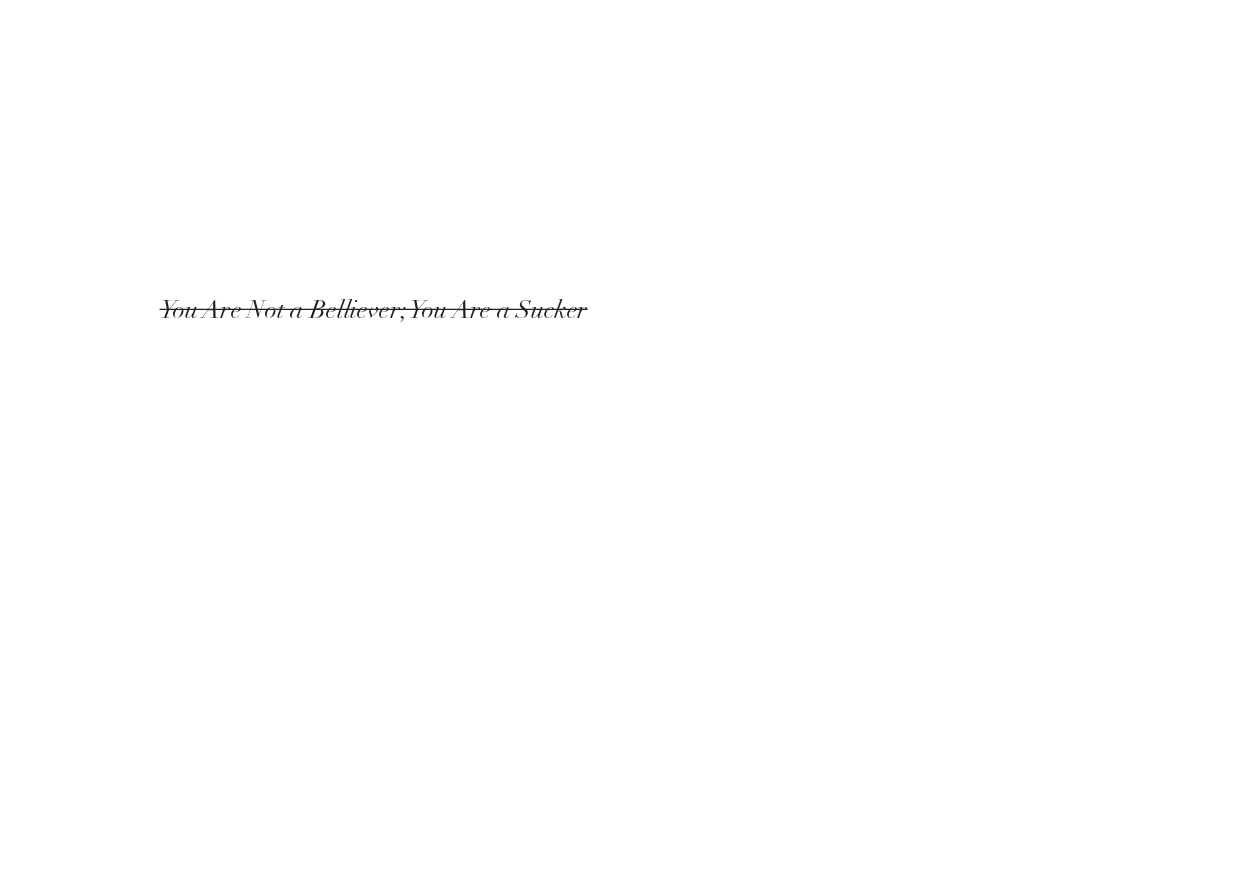






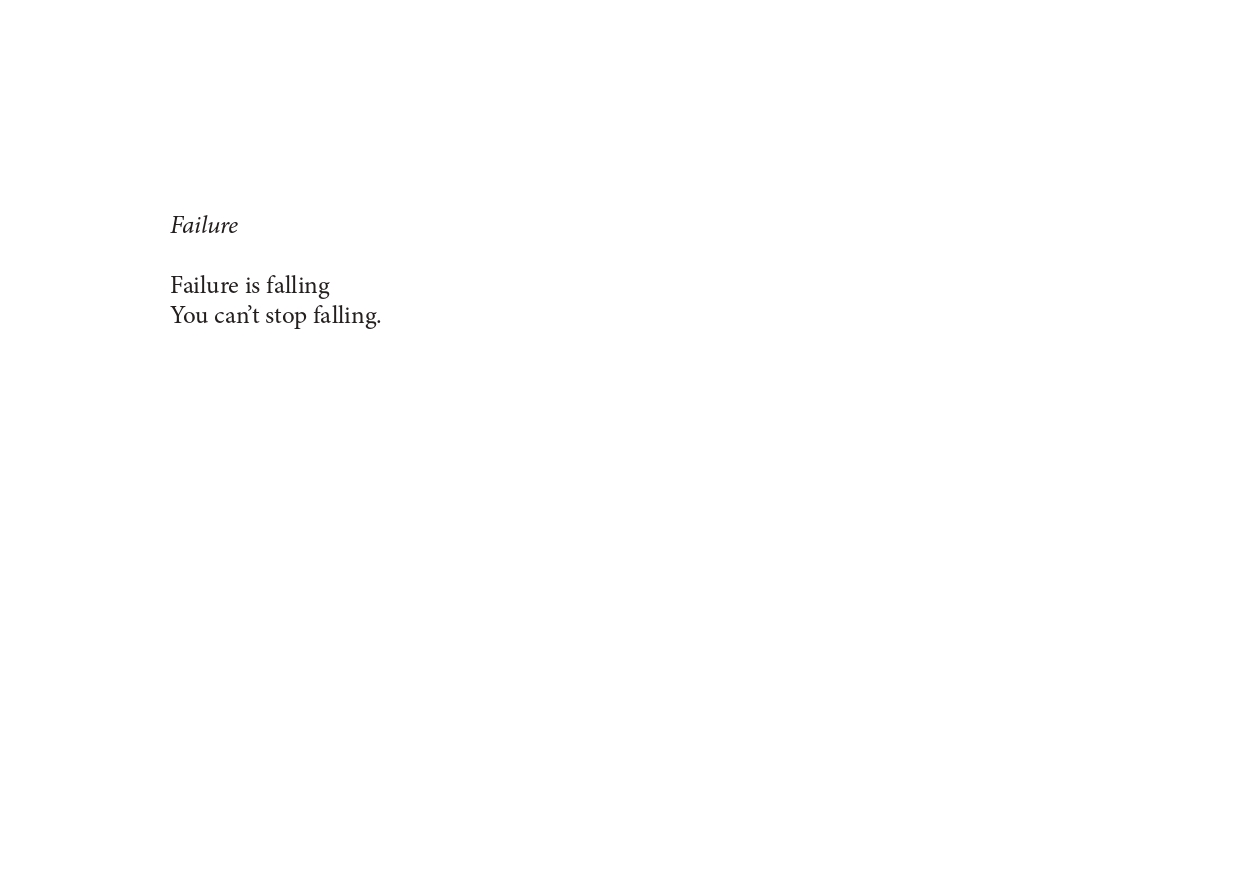

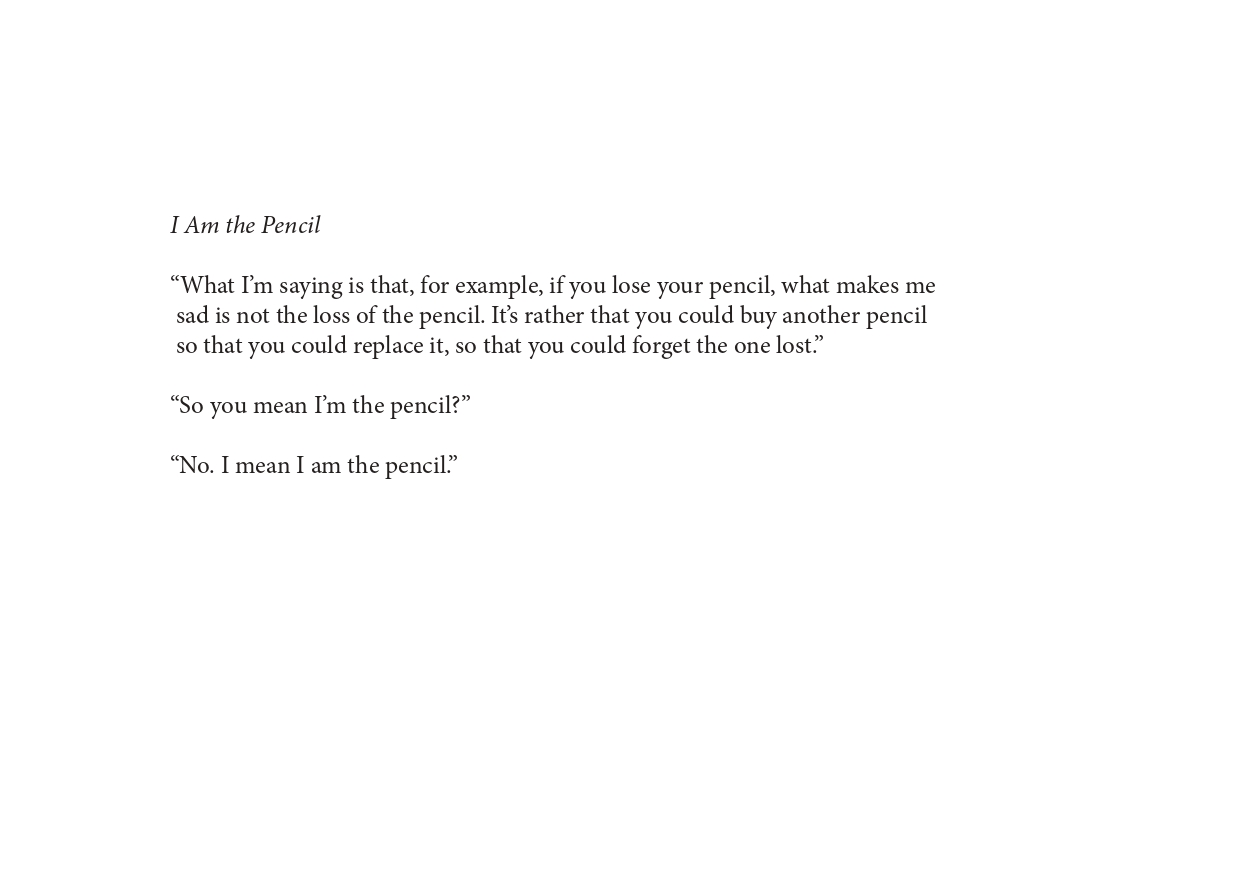




2018
When I lived in another country for 15 months, M was my best friend there. She had blond hair, pale skin, turquoise colored eyes. She talked lazily like a nanny who tried to hypnotize a baby. It was not exactly sleepy sound but sound for sleep. I loved her voice. We liked to be drunk. I mean, completely wasted. We made some mistakes without shame. Afterwards shame was manageable to us or we did not need to manage them anyway. We were young. We were like a wild animal who roamed in the dark. When I had to leave the country, it was very hard to us. I was going back to home where was so far from where she was. We could not know when we could meet again. Maybe very soon. Maybe never. We spend many nights for farewell parties. Then just a day before me leaving, M and I decided to go to a park for the last time before my departure. It was winter. It was cold. The sky was clear. We were 100% sober. The park was big and beautiful. There were many huge Platanus trees. We strolled along the old trees for a long time. After the pleasant stroll, we warmed up ourselves in a canteen-like cafe in the park. Drinking tasteless coffee, we were talking about the future. The unseen and unheard future was strong enough to scare us. We were kids frightened by the notorious future.
We started strolling again. Walking in the cold and dry air, between trees, was a kind of ceremony. When we almost reached the other side edge of the park, we found a maze made of dense thickets. We entered in to the maze for fun. Soon, I realized how easy I could be disorientated. We were rushing around the maze. Forward and backward. Backward and forward. To cover the underneath anxiety, we were laughing as if it were a funny game. We were completely lost in the maze. In the maze in the park in the foreign country. At last, we were able to get out of it when we found a shortcut sign made for people like us who gave up on finding the exit. It was the last thing we did together. We could have done something more special and meaningful. But, we chose being in the maze together in a chilly winter day. Since I left the country, we sometimes sent emails or letters to each other. We have never talked about my last day in the park, though we still talk about the future. We are still frightened and worried. She still has blond hair, pale skin, turquoise colored eyes. We are still kids, but we are not young anymore.
2018
1)
This is all about language or words. Yes. Everything is about this, as language believes that it can explain everything. Or at least it dares to attempt it.
Q used to say Everything’s Possible. She also used to say Nothing’s Forever. Whenever she spitted out these sentences, I said Yes, Yes. There was no No. Even though when No meant not so different from Yes, you better be cautious with No. Because No is just too strong word. Sometimes, Yes is a euphemism for No.
You need to watch out for your words. Petty things matter for lots of people. Almost everyone including you. We think we are generous enough to understand what displeases us, as we have put up with lots of stuff, such as colonization, such as pollution, such as capitalism, such as our own adolescence. Nevertheless, we embrace very little amount of language. We all are small-mined to a certain extent. The most unfortunate part, however, is not that we are small-mined. Real tragedy starts with this fact that our small minds can dream and there is a fantasy where no other enters.
Q told me that I was in a complete fantasy. She said what I said did not make sense. Then Q scoffed at me as if she was the one who was able to understand me more than anyone else. As if she met the real me, and touched it, smelled it and ate it. I could not respond. I could not say Yes or No. It was something excluded from all of Yes or all of No.
2)
If you have an experience of working in a restaurant, you know that you need to say I Am Sorry many times. If the customer says It is too cold, It is too hot, It is too sweet, It is too blend, It is too small, It is too big, It is too much, It is too little, there is only one reply available: I Am Sorry. It does not matter whether you are actually sorry or not. Sorry was originally invented for the possible situation that you do not sorry but you do not know what to say. This word allows turning back to zero. Zero is comfortable/convenient since no one has to be responsible for it.
The more I was with Q, the more I had used similar words that Q had used. Her vocabulary, phrases, jokes and errors. There must have been many words that I knew but I had never used. One day I said a particular word(I do not remember what it was). She was very surprised by that. She asked me. “Where did you learn that word?” “I’ve always known this word.” “ I didn’t know you knew that word. It was used in a correct situation.” Q was laughing. Q was laughing as if it was really funny.
There was the period that she mentioned Nothing’s Forever much more than Everything’s Possible. It was the time of Nothing’s Possible. It was the time that we were in constant Summer. Constant Sun. Constant bottles of cold milk tea. Constant bad sleeps. And then, things stopped and remained there.
I agreed with Nothing’s Forever, yet I believe this; the thing dreamt of being forever dies and sleeps in the eternity. This fantasy enabled my reality. This fantasy enabled the person called my name. I know, Forever is an ambiguous word. Eternity is an ambiguous word. Ambiguous is an ambiguous word. But hey, Everything’s Possible.
View The Original Text PDF (English and Korean)
A participation with three pieces of short text in the 5th issue of a small publication, Memori whose content written in bilingual, English and French.
They are:
Almost There(2024): Maze(2018, 2024) written in 2018, rewritten and rereleased in this publication: and lastly, I Was Delighted to See You Becoming a Poet(2020), only piece originally written in English out of the 7 selected Korean poems disclosed as a visual work on half-transparent paper in the solo exhibition in 2020.
영문과 불어로 구성된 소규모 책자 MEMORI의 5번째 발행본에 3개의 짧은 영문글로 참여
Almost There(2024), 2018년에 작성했다가 이번 기회에 재록해 새롭게 발표하는 Maze(2018, 2024)와 2020년 개인전에 반투명 종이 위에 시각 작업으로 발표한 7개의 한국어 시 중에 유일하게 원래 영문으로 쓰인 시, I Was Delighted to See You Becoming a Poet(2020)의 오리지널 카피가 함께 수록되었습니다.
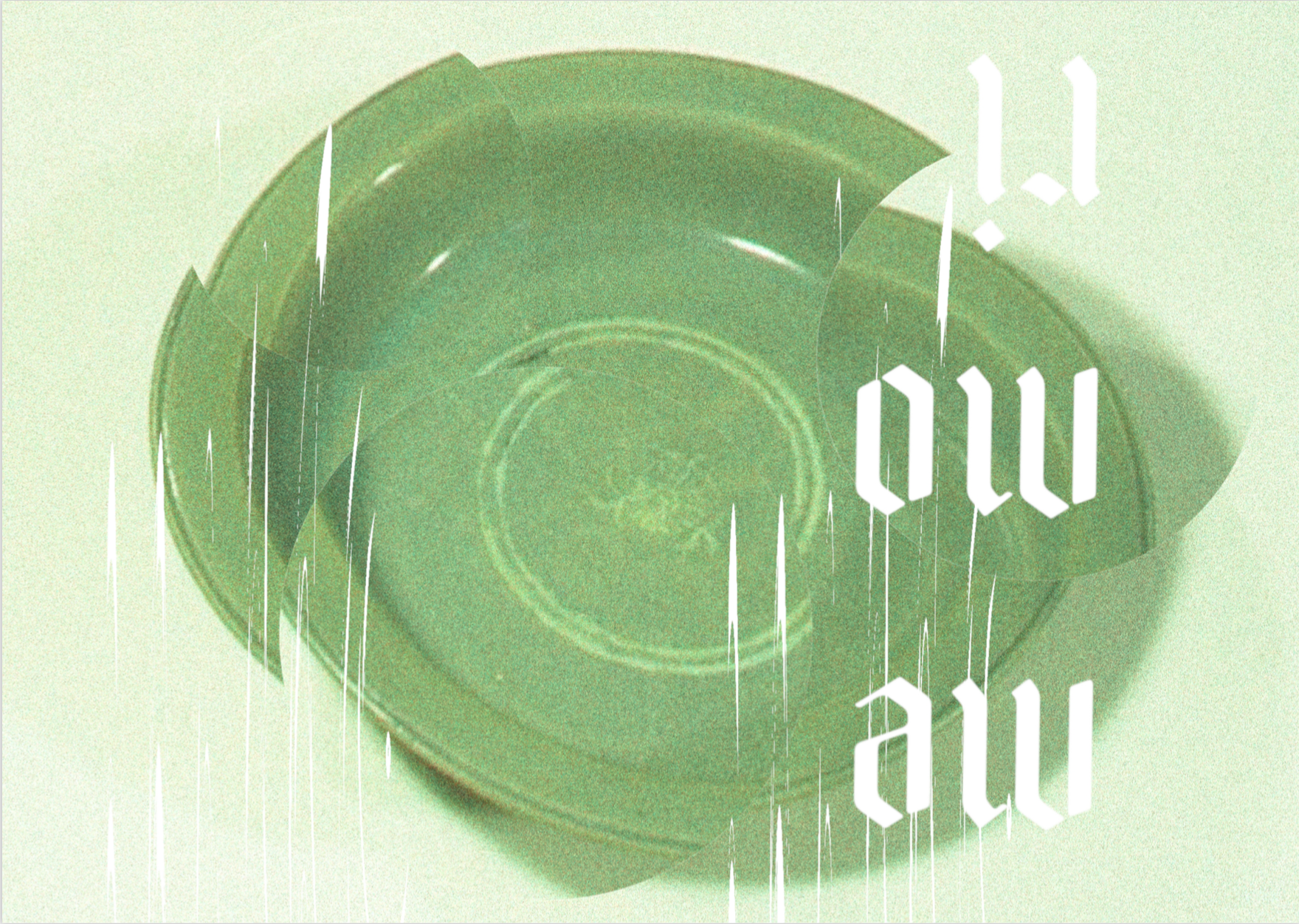
콜라보레이션 프로젝트 컨투어
Ongoing Collaborative Project
(Project Website)
In Collaboration with Ted Oonk (website)
Photography, Letters, Text, Sound, Video, Installation and Publication
Contour(2015-present) is a multi-disciplinary collaborative project by two visual artists, Ted Oonk(NED) and Su Jung(KOR). By establishing a fictional anonymous island, the artists produce hypothetical narratives to explore the conceptual influence of division, categorisation, alienation and conflict. These notions illuminate the dark sides of our civilisation, closely connected to constantly controversial issues, such as discrimination, immigration, refugees and social isolation. As the artists have entirely different cultural backgrounds, the collaboration suggests a wider-range interpretation of those matters and addresses uncomfortable questions about our biased ways of thinking. In terms of media, it embraces various fields: photography, installation, video, audio, objects, publication, letters and other undefined experimental outcomes, including conversations. Thus, Oonk and Jung's persistent commitment to the project for several years has steadily developed into a thick volume of visual research on how an isolated self experiences and deals with her and his outside.
컨투어(2015-현재)는 시각 작가 테드 웅크(네덜란드)와 정수(한국)가 협업으로 진행 중인 다학제 프로젝트이다. 프로젝트는 이름 없는 가상의 섬을 설정하고 이에 따른 서사를 구성하여 구분, 범주화, 소외 등의 개념이 가진 영향력에 대해 연구한다. 이 개념들은 우리 문명의 어두운 단면을 비추고, 나아가 차별, 이주, 난민, 사회적 고립이라는 지금까지도 논란이 된 이슈와 긴밀히 연관되어 있다. 전혀 다른 문화적 배경을 가진 두 작가는 협업을 통해 위에서 언급된 문제들을 다각도로 해석하고, 편견이 개입된 우리의 사고체계에 대한 불편한 질문을 던지고자 한다. 매체적으로 이 프로젝트는 사진, 설치, 비디오, 오디오, 오브제, 출판물, 편지뿐 아니라 대화와 같이 규정되기 어려운 다양하고 실험적인 결과물로 이어져 왔다. 수년간 지속된 두 작가의 일관된 탐색과 조사는 결국 고립된 개인이 외부를 경험하고 마주하는 방식에 대한 심도 있는 시각적 리서치로 발전해 오고 있다.



The letters of the collaboration project with Ted Oonk, CONTOUR are included in Issue XXI of United Project Newsletter. This is currently published online. Each twelve issues will be published into a hard copy volume and distributed to libraries and museums around the world.
View the Online Issue
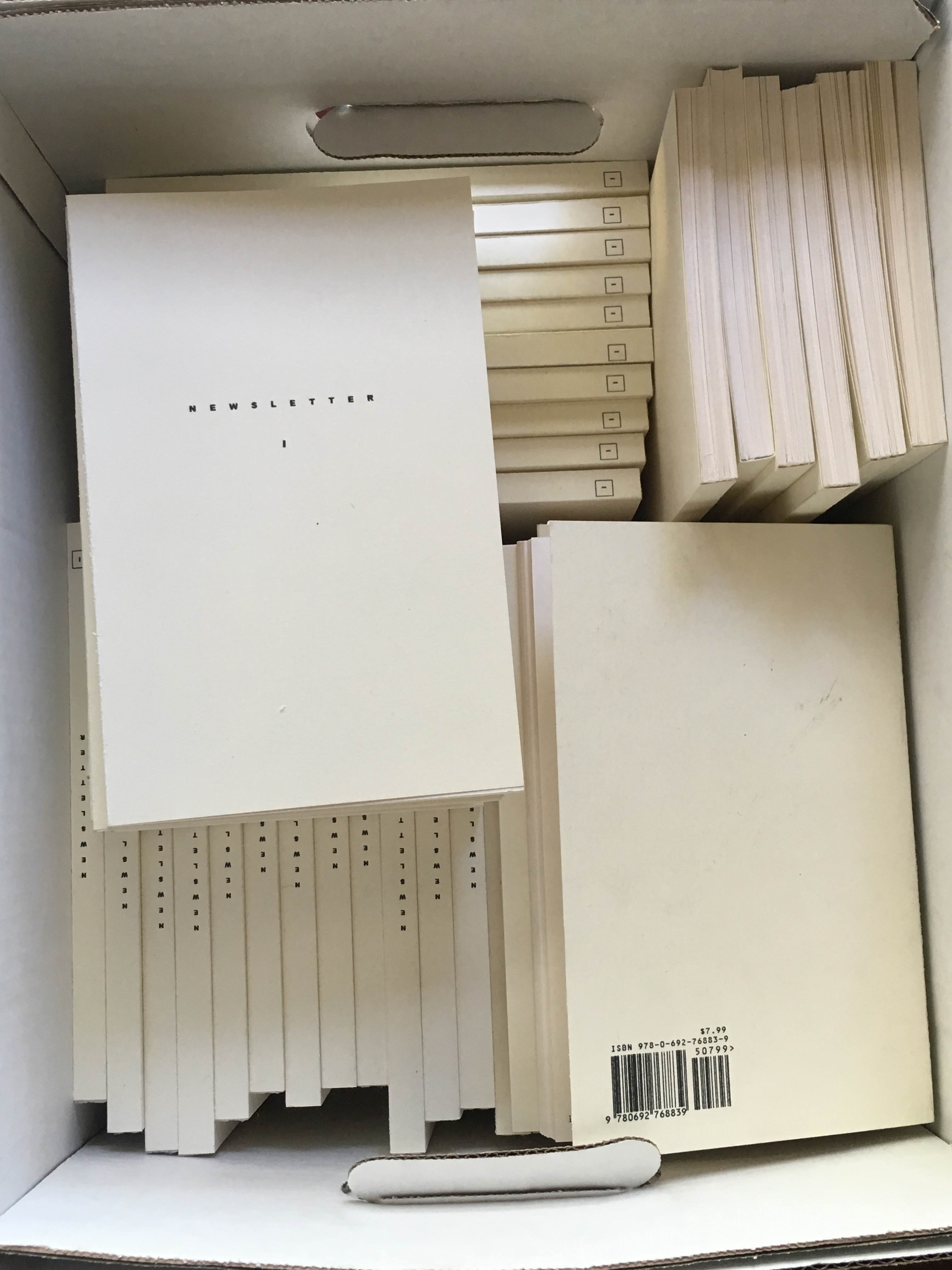
매일 밤 온몸을 열고 새가 사막을 건너오길 기다렸네
[Somebody's Somebody] series #6
시리즈 누군가의 누군가 #6
Book (Selected Short Stories and Poems), 146x221mm, 100 Pages, 50 Edition © Su Jung
Production Supported by Seoul Foundation for Arts and Culture
Purchase Inquiries: Email here hyunsujung46@gmail.com
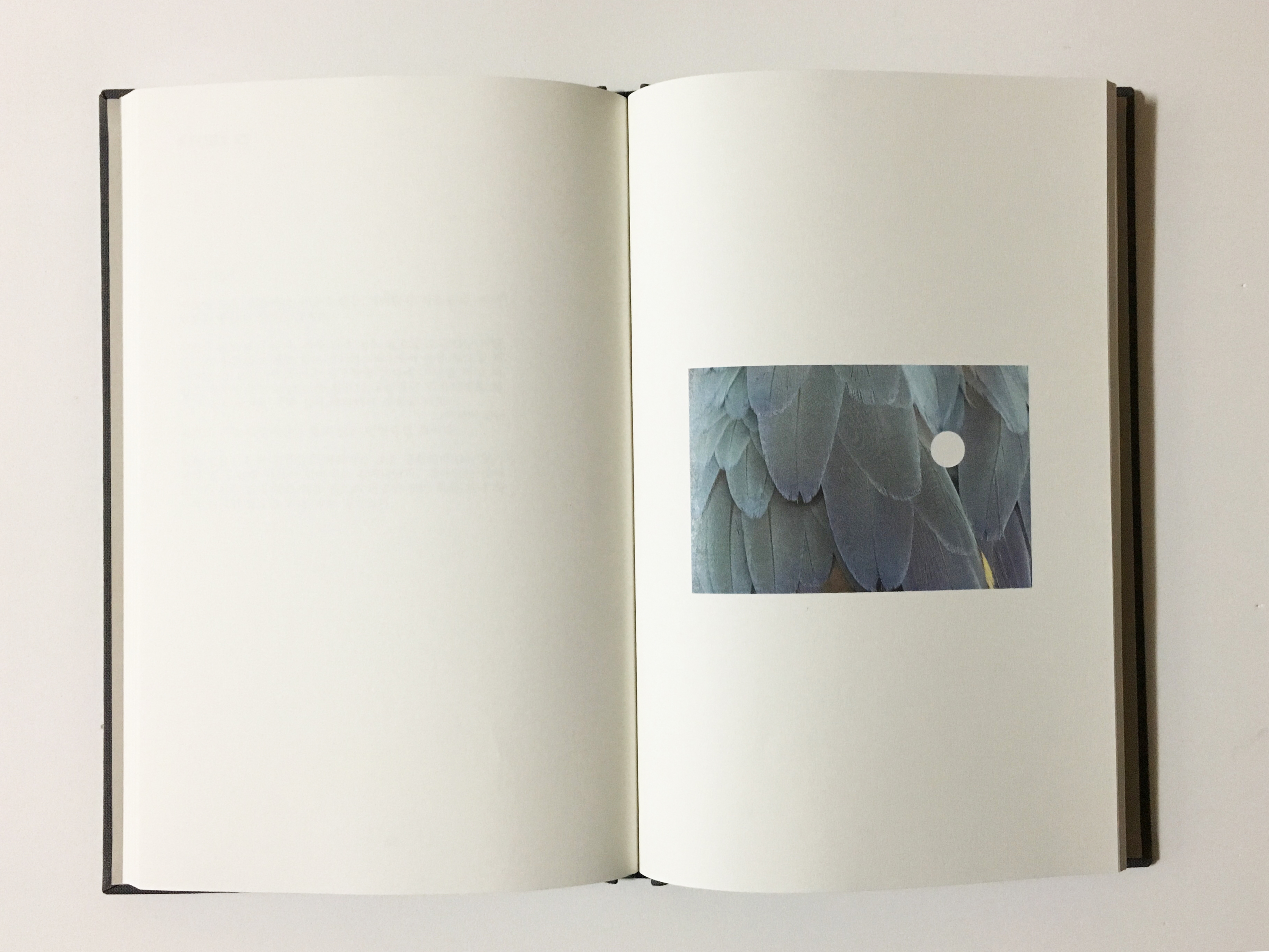
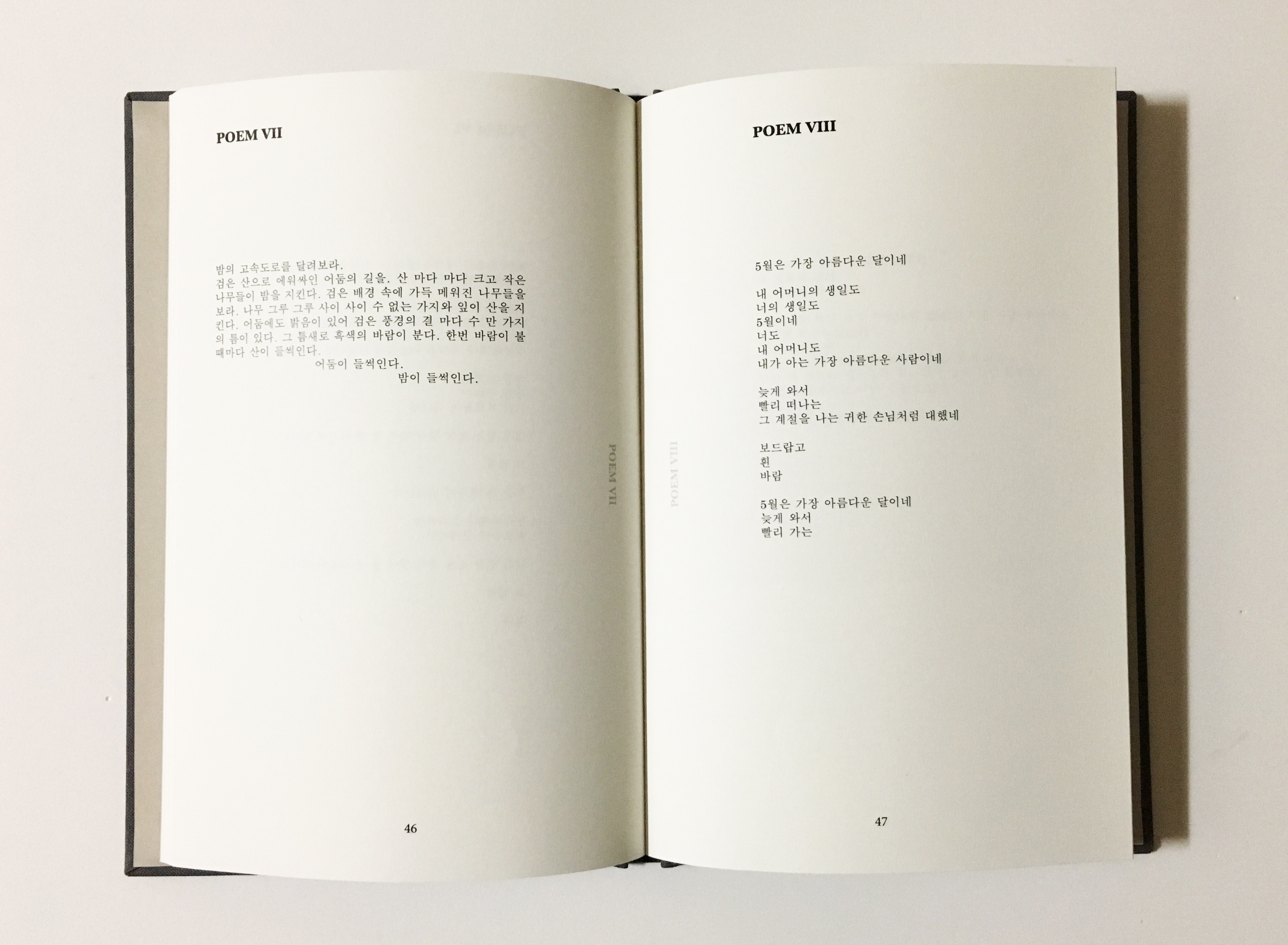
그렇게 과거가 된다
Booklet, 128 x 182 mm, 40 pages, 100 editions © Su Jung, Ted Oonk
Published in 2017
Text Written by Su Jung in 2015 - 2016
Part of Project CONTOUR in Collaboration with Ted Oonk
Book Review by Open Eye Gallery, Liverpool
Korean Translation Version Inlay, < 그렇게 과거가 된다>, 128 x 182 mm, 16 pages, 30 editions







시간과 물질에 관한 사례집
In collaboration with Alex Whittaker
185 x 256 mm
Booklet, 24pages, 200 Editions © Su Jung & Alex Whittaker
20 short texts written in Seoul & 20 edited images from the Internet
Production / Limg E.Y
Supported by Korea National University of Arts Art Theory Dept

